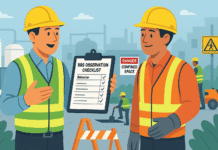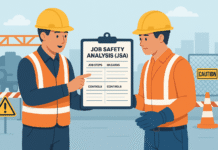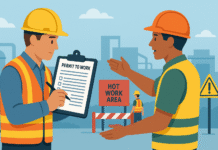
ADNOC HSE Interview NOTES (Questions & Answers)
ADNOC HSE Interview Notes
1. Road Safety
1. Speed limit
2. Wear seatbelt, no smoking in the vehicle
3. Vehicle daily inspection check list should be filled
4. Flag pole/rollover bar/first aid kit/desert kit
5. IVMS-in-Vehicle Monitoring System-GPS to track and monitor the vehicle activity (location, driving speed, seatbelt, struck)
6. Journey Management Plan
7. Summer 8:00pm winter 7:00 no driving without journey Management Plan
Speed limit: Asphalt Road 100. Part 80 slop and turning 40
Gatch Road 40& Sand 20-30
IVMS:In-Vehicle Monitor System. How it work, Please explain (answer in the Road safety procedure)
RAG Repor: Red(Reject/unsafe)
Amber (Average-Need more training)
Green (Good behavior)
JMS:Journey Management Plan— 3 factors: Driver, vehicle, road
Maximum driving time between breaks: Light vehicle 2h heavy vehicle 4 hours; Minimum break time 15mins
Medical: <40,3years
40-50,2years
≥50,1year
What’s Fog level: 100 meter
2. H2S
Ans.:Hydrogen Sulfide, A colorless toxic heavier than air rotten egg smell、Silent Killer which exist in crude oilfield、sewage treating plant
PPM: Part per Million
10 PPM monitor will alarm and human can work less than 8 hours one day or 5 days one week
15ppm STEL (Short Term Exposure Limit)
20ppm Ceiling value (this area will not approached without Breathing apparatus)
500 ppm is the lethal limit
100 PPM is IDLH (Immediately Dangerous to life and health)
LC1–650ppm LC50-1000ppm LC100-1320ppm
Leakage:
1. Wear EEBA (Emergency escape birthing apparatus 15mins), reach the safe location
2. Stop the equipment if possible, Do not try to rescue others
3. Check the wind sock, firstly go across the wind ,then go up the wind to assembly point
4. Call the Supervisor
SCBA(Self Contained Breathing Apparatus) only for rescue,45mins
3. Welding work
Ans.:
1. PTW
2. Gas test
3. Isolation (If it’s Required)
4. Thirty party certificate of the welder and welding machine
5. Check the welding area
6. Fire watcher with fire extinguisher
7. Fire Blanket
8. PPE(welding mask, leather gloves, leather clothes, long safety shoes)
4. Lifting work
Ans.:
1.PTW
2.Third party certificate of equipment and riggers(crane and lifting gears)
3.Crane check list will be filled by the Operator( Park on level and solid firm ground, outriggers have fully extender, wooden plate, no hydraulic leakage.)
4.Barried the lifting area(under boom radius)
others:
Safety device of crane:
1. Anti-two block
2. Safety latch
3. Spirit level
4. LMI-Load Movement Indicator(anemometer、overload、complete control of crane)
5. swinging alarm
How many type of lifting?
1. Normal lifting
2. Critical lifting
3. Heavy lifting
Once wind speed exceed 17 knots, lifting activity shall be stopped.
4.1. Name of three potential hazards associated in lifting activity and what is color coding?
Ans.:Fall of load or equipment personnel/facility struck by load/ equipment, weather conditions (sand storm, wind speed (stop lifting at wind speed of 17 knots).
Color coding: color coding means that instruments is in good condition with third party certification.
Visually inspection with third party certification. All things are good putting one identification on that instrument.
4.2 How you know that crane can lift this much of tones in this radius?
Ans.:By checking Load chart
5. Excavation
What is excavation what is the difference between trench and excavation?
Excavation is a process of moving or digging earth rocks or other materials at ground manually or with mechanical equipment.
Excavationas any man-made cut, cavity, trench, or depression in the earth’s surface formed by earth removal.
Trench is defined as a narrow underground excavation that is deeper than it is wide, and is no wider than 4.5 meters.
Access every 5meters (15-20 feet).
Excavation PTW requirements?
1. PTW
2. Excavation Certificate
3. Area scanning report by surveyor and signed by HSE
4. Third party certificate of equipment and banks man.
5. Check the soil, if loose, sloping, benching and shoring
6. Barricade the excavating area and put safety signs (more than 1.2 hard barrier)
7. Keep 1 meter edge clear
Others:
Controls?
1) Shoring, 2) Shielding, 3) Sloping, 4) Benching.
Type of soil and How much angel to be provided for sloping:
Stable Rock -90 degree.
Type A- 53 Degree slope to be maintained for sloping
Type B-45 Degree slope to be maintained for sloping
Type C-34 Degree slope to be maintained for sloping
5.1 What are the Main hazards in Excavation activity?
Ans.:Underground utilities, Collapse of excavation wall/Cave in, limited access and egress, presence of toxic gases, falling of person, falling of vehicle, falling object on the person who ever working in excavation. Adverse weather.
5.2. What are the safety precautions for excavation?
Trenching and Excavation Rules
Ans.:
● Keep heavy equipment away from trench edges at least 3 meters.
● Keep surcharge loads at least 1 meter from trench edges.
● Know where underground utilities are located.
● Test for low oxygen, hazardous fumes and toxic gases.
● Inspect trenches at the start of each shift.
● Inspect trenches following a rainstorm.
● Do not work under raised loads.
● Provide proper shoring benching or sloping where required.
● Provide proper hard barrication which is visible from distance.
● Provide proper safety signage boards.
6. What is confined space?
Ans.:Generally speaking, a confined space is a fully or partially enclosed space that:
It is not designed for continuous human occupancy, It has limited access may be have presence of toxic or flammable materials /gases, Oxygen deficiency, oxygen enrichment.
Configuration that can complicate first aid, rescue, evacuation, or other emergency response activities
● Can represent a risk for the for the health and safety of anyone who enters, due to one or more of the following factors:
o its design, construction, location or atmosphere
o the materials or substances in it
o work activities being carried out in it, or the
o mechanical, process and safety hazards present
Confined space: pit more than 1.2 m
Excavation: less than 2:1(width to depth)
Hazards in CSE:Toxic materials/gases, Poor ventilation, Enrichment/deficiency Oxygen) Flammable gas/materials, Excessive heat
CSE Procedure:
1. PTW
2. Man-hole watcher/standby
3. Gas test (H2S-0 oxygen-19%-22.5%、CO、LEL)
4. Rescue System (safety harness/life line), outside lifting
5. Fresh air supplier
6. Frequent break
7. Communication device.
8. Scaffolding is a temporary platform for working
Ans.:
1.Types of Scaffolding: Mobil scaffolding, suspended scaffolding, Ground Scaffolding
2.Sole board, base plate, standard, ledgers, transom, scaffolding board/blanks, toe board, guard rails(Middle rail- 470mm and toprail-950mm ), bracing, supports and ladders
3. Inspected by the scaffolding inspector, inspection valid-7 days.
4. Scaffolding Stand: BS-EN18211:2003
Tubes:EN39
Coupler: EN74
5. Kick lift (150-200mm)
6. Ladders (1 m more than the platform).
1. What are the Terminology for the scaffolding as per BS 11397.nv
Ans.:
Bay length: (Distance of two standards) Very light duty-2.7mts, Light duty-2.4Mts, Medium duty-2.1Mts & Heavy Duty 1.8mts.
Kicker lift (150mm From Ground level), Sole board, Standard, Ledger, Bracings, Outriggers, toe board (the upstand at the edge of the scaffolding platform)-150 mm height. Scaffolding planks (225mm and 37 mm thickness) mid rail (40cm – 45 cm height). Top rail (90cm- 1 mtr. Height)
Different type of scaffold :
Very Light Duty-75kg/ m2
Light Duty-150kg/ m2
Medium Duty-200kg/ m2
Heavy Duty-250kg/ m2
9. Isolation
Ans.:We need to control the source on energy before starting any hot work, like any live electrical wire, any pipe with gas or toxic materials inside we need to cut off the power supply for that live electrical wire we need to isolate the pipe line and make it clean first
10.Lockout &Tagout
Ans.:This system is used to do the isolation. We need to lock out the source(like electrical switches, pipe line valves) after putting lock we need to put a tag also with the name and contact number of the person who did the isolation.
11.What action you will take in case of any incident or accident?
Ans.:
Heat stress:
Call for emergency help immediately.
Move the victim to a cool shaded area.
Loosen and remove any heavy clothing
Have the person drink cool water (about a cup every 15 minutes) if alert enough to drink something unless sick to the stomach.
Cool the person’s body by fanning and spraying with a cool mist of water or wiping the victim with a wet cloth or covering him or her with a wet sheet
OR
Lay the victim down & apply cool wet cloths to exposed skin. Get medical help immediately. Call ADNOC control room for medical assistance.
H2s leak:
Stop all activities
Switch off all equipment’s and machineries safely
Check the wind direction & move upwind direction towards your assembly point.
Wear your escape hood
Head count to be conducted as per tool box meeting record.
Ensure no personals are left behind before boarding the standby vehicle & evacuate if someone is missing immediately inform ADNOC control room
Report for any casualty
Wait for further instructions and do not return to the work area until declared safe.
Remain calm obey instructions.
Personnel injury:
Try to move the patient from the position he is in, if the area is safe.
Certified first aider to give first aid to the patient reassure him and camp clinic or ADNOC clinic.
Inform project site HSE manager and ADNOC representative.
Wait till the assistance arrives.
Don’t panic.
Fire:
Operate the nearest fire alarm call point and dial ADNOC control room
Only attempt to fight the fire if it is safe and practical to do so using the most appropriate fire extinguisher for the type of fire you intend to tackle. Don’t use water on electrical or flammable liquid fires.
Report to assembly point
Don’t panic.
If fire is big call ADNOC control room immediately.
12. Electricity.
Ans: All equipment on site is 110 voltage, check the condition of cables…….
13.Define hazard and give example?
Ans.:Hazard is anything or any source which have a potential to cause harm, illness fatality or property damage.
Types of Hazards
- Biological Hazards
- Chemical Hazards.
- Ergonomics Hazards.
- Psychological Hazards.
- Radiation Hazards.
- Physical Hazards.
- Electrical hazards.
- Mechanical hazards.
14. What is an incident/accident or near miss?
Ans.: INCIDENT:An unplanned undesired event which delays the completition of work and which may cause illness injury or property damage
ACCIDENT:Is an unplanned uncontrolled event which causes illness injury fatality and property damage.
NEAR MISS:Is an unplanned event which did not caused any injury illness or property damage but has the potential to do so.
15.Mention any 3 high risk activates?
Ans.:Work at height more than 10 meters
Welding job in live facilities area
Confined space job
Lifting over live plant
16. How many types of permit ADNOC have?
Ans.:ADNOC have three types of Work permit.
1. General Work Permit.
2. Hot Work Permit
3. Critical Work Permit.
17. How many types of certificates ADNOC have?
Ans:Types of certificates associated with ADNOC Permit to work system
- Excavation Certificate
- Confined Space Entry Certificate
- Control protection Inhibit certificate
- NORM handling certificate.
- Vehicle Entry Certificate
- Isolation Certificate
- DE isolation certificate
- Radiography certificate
- High Voltage Certificate
18.What is ADNOC Life Saving Rules (LSR)?
Ans:
1. Work Authorization
(Obtain a valid Permit whenever required)
2.Confined Space
(Obtain authorization before entering a confined space)
3.Bypassing Safety Controls
(Obtain authorization before overriding or disabling safety controls)
4.Energy Isolation
(Verify isolation and zero energy before work begins)
5.Driving
(Follow Safe Driving Rules)
6.Working at Height
(Protect yourself against a fall whenever working at height)
7. Line of Fire
(Keep yourself and others out of the line of fire)
8.Safe Mechanical Lifting
(Plan Lifting Operations and Control the area)
9. Toxic Gas
(Follow the rules for working in toxic gas environment)
10.Hot Work
(Control Flammable and ignition sources)
19.What are the activities for a pipe line work?
Ans.:Transportation of Pipe lines, Right of Way (ROW) in sandy Area, Stringing, Bending, cutting, grinding, welding, field joint coating, Nondestructive test (NDT)Pre- padding and post padding, Hydro testing, De commissioning and de-oiling of existing lines. Restoration.
20.What is HSE Plan and what are the contents in the HSE Plan?
Ans.:It is the systematic procedure which is describe how to carryout work in a safe manner by protecting health safety and environment.
The Contents are Project Title, Index, Introduction, scope of work, leadership and commitment, HSE Policies, Strategic Objective and Targets, Organization chart, Resources, Roles and Responsibilities, HSE Competency, Risk evaluation and Management, Planning standards and procedures, Implementation and Monitoring, Audit, Management Review and Annexures.
21.What is the base of HSE Plan? And what are the elements?
Ans.:HSEMS (Health Safety and Environmental Management System). Elements are Leadership and commitment, Policy and Strategic Objectives, Organization resources and competence, Risk Evaluation and Management, Planning standards and procedures, Implementation and monitoring, Audit and Management Review.
22.. What is the HSE Policy?
Ans.:It is the overall view of the organization towards HSE, it is a legal requirement, it is top management commitment and it is signed by senior most person of the management.
23.What is HSEMS?
Ans:
1.LEADERSHIP AND COMMITMENT
2.POLICY AND STRATEGIC OBJECTIVES
3.ORGANISATION, RESPONSIBILITIES, RESOURCES, STANDARDS AND DOCUMENTS
4..HAZARD AND EFFECTS MANAGEMENT
5.PLANNING AND PROCEDURES
6.IMPLEMENTATION AND MONITORING
7.Audit
8.Review
24.What are the important elements in HSEMS?
Ans.:1. Leadership and Commitment.
2. Risk evaluation and Management.
25.What are the elements will be briefed for HSE Induction?
Ans.:HSE Policy, Emergency preparedness ( Moke drill plan, Evacuation Plan, Assembly point, First
aid facility, Ambulance, Medical clinic, Emergency contact Numbers.),PTW system of the site, Welfare facilities, work related procedures , Mandatory PPE and Work related PPEs. These are the minimum will be briefed during HSE Induction.
26.Who is authorized to do gas testing? Job performer can conduct gas test in his area, why?
Ans.:Only Authorized gas tester (AGT) shall be conducted the gas test.
Job performer cannot conduct the gas test because he can be manipulate the things and maybe he will allow to work.
27.What are the items will show during gas test?
Ans.:H2S (below 10 PPM), LEL (less than 5%), oxygen level (19.5%-22.5%), Carbon oxide. LEL for Hydrocarbon.
28.Which permits shall be obtained for Radiography?
Ans.:In restricted area: Cold work and Radiography certificate.
Unrestricted area: Only Radiography certificate.
X ray use high voltage transformer: Hot work and Radiography certificate.
29. What are the HSE requirement for Radiography?
Ans.:Experience history, Medical History, Radiation Protection Supervisor shall be qualified with certification (Recognized certificate from NRPB {National Radiation protection board} from UK). Work instruction’ Method statement, Emergency Action Plan, Emergency contact numbers, Emergency Kit, Personnel Dossi meter and Calibration certificate, surveyor meter and calibration, TLD badge for Personnel, Source transportation vehicle shall be approved from FANR (Federal authority for Nuclear Regulation), Source storage requirements and Source movement control log.
29.1How you will decide area of barricade for the radiography activity?
Ans.:By using surveyor meter (Analog and digital surveyor meter is available).
30. What are the safety devices for Radiography activity?
Ans.: TLD Badge and personal Dossi meter, koli meter, surveyor meter, emergency kit, emergency action plan. Beepers.
31.What are things you know about H2S? TLV? STEL? LEL? UEL? IDLH? Auto ignition temperature?
Ans.:H2S is heavier than air (1.19), invisible, Toxic, poisonous, corrosive, flammable, pyrophoric, Soluble in water & oil, rotten egg smell in low concentration (below 1ppm).
Threshold Limit Value (TLV): 10 PPM for 8 hours.
Short Term Exposure Limit (STEL):15PPM. (The concentration which it is believed that a person can exposed continuously for 15 PPM without any danger to health, irritation and his safety).
Lower Exposure Limit (LEL):is4.3 %( 43000PPM).
Upper Exposure Limit (UEL):46 %( 460000PPM).
Immediate Danger to Life and Health (IDLH):above 100PPM.
Auto ignition temperature:500 F (260 c).
32. What are the breathing apparatus you can use in the plant?
Ans.:EEBA (Emergency escape breathing Apparatus) – For evacuation purpose.-15 Minutes of duration.
SCBA (Self Contained breathing apparatus)-For Rescue operation and confined space work purpose.-30 Minutes of duration.
CABA (Continuous Airline Breathing apparatus).
33. What is the Emergency response while listening the siren?
Ans.:Stop the activity what you are doing, shut off all the equipment’s, watch wind direction and proceed to assembly point by cross wind direction, then check the head count and inform as per incident protocol.
34. What is the Emergency response while your personnel monitor giving alarm?
Ans.:Stop the activity what you are doing, shut off the equipments, Hold the breath, don the EEBA(Emergency Escape Breathing Apparatus),watch wind direction, proceed to safe location by cross wind direction, then upwind direction and go to nearest assembly point , check the roll call/ head count. Inform as per incident protocol.
35. What are the devices to identify H2S at site?
Ans.:Fixed Detectors, Personnel monitors, Multi gas detectors, Wireless detectors.
36.What are the steps for Task Risk Assessment (TRA)? And Who will prepare the TRA?
Ans.:SI.No. Job Steps, Cause, Consequences, Potential Risk, Existing Barriers/Controls, Recommended controls, Action by, Residual risk, ALARP (Yes/No), Completion date.
TRA Will prepare by TRA team
37. What are the typeof risk will identify in the TRA?
Ans.:Potential Risk and Residual Risk
38. If you cannot make ALARP for an activity what control measure you will take?
Ans.:Close supervision from higher authority and give more care about that activity more than Normal precautions and control Measure.
39.What is Residual Risk?
Ans.:The Existing risk after implementing the control measure.
40. What are the precautions for Hydro testing?
Ans.:Don’t forget to tell this first. All fittings, joints, flanges, blinds & hoses shall be rated. All the Gauges shall be calibrated and certified.Pressure safety Valve shall be installed in test line to prevent the test pressure being exceeded. Whip arrestor shall be provided for all joints. All gauges shall be installed in a safe distance from equipment and should be visible to operator.
41. Types of Fire?
Ans:
Class A: Combustible materials (Solid)
Class B :Flammable Liquids.
Class C: Flammable gases.
Class D: Metal Fire.
42. Hierarchy of control measures?
Ans:
1.Elimination
2. Substitution.
3.Engineering control
4.Administrative control
5. PPEs
43.Sand Blasting.
Sand blasting operations can be overlooked when preparing safety plans because they are generally a small part of a larger project such as cleaning and refinishing or painting. As a result, many workers are exposed to the hazards of sand blasting without adequate protection. Even if all sandblasting equipment is properly designed and regularly inspected, users must always be alert to the hazards of these operations and take precautions against harmful exposures. 6
Airborne dust: This is one of the most serious hazards associated with blasting operations. When evaluating this hazard, it’s important to consider the concentration of dust and the size of particles. Larger particles, considered “nuisance” dust, are normally filtered out in the nose and throat. Smaller particles (10 microns or smaller) can bypass the lung’s filtering system and penetrate deep into the respiratory system, where they may cause serious damage. Safeguards are needed when smaller particles are present in the working environment. Metal dust: in addition to the abrasive being used, contributes to the generation of airborne dust. Metals such as lead, cadmium, and manganese, can be extremely toxic when inhaled. Many existing paints have a lead base. Regulations require special handling, trained personnel, and medical monitoring when lead is present. If in doubt, check it out. Don’t guess.
Silica sand: This product is a potentially serious health hazard and should not be used as an abrasive. If silica containing (quartz) materials are selected for any reason, workers must wear a positive pressure or pressure demand respirator with an assigned protection factor (APF).Silica must be contained and disposed of properly. Even if a wet blasting method is selected, silica that is allowed to migrate by either wind or water, will eventually become an airborne contaminant. .
PPEs for Sand Blasting: Hearing protection for both operator and nearby workers. Heave duty gloves or leather gloves, Apron, Respiratory mask, Safety Shoe, coverall, face shield, etc.
44.Handling and storing compressed gas cylinders.
Store cylinders in shaded area.
● Secure cylinders upright with a chain or strap in a proper cylinder cart.
● Store cylinders at least 30m from hot work location and combustible materials in a dry, ventilated place.
● Keep oxygen cylinders at least 20 feet from fuel gas cylinders.
● Ensure valves are completely closed and any protection devices are secured.

























Very nice shows professionalism